
Irons on display at the Powysland Museum. From left to right:
charcoal iron, two box irons, a flat iron and an Italian iron.
A crimping machine is behind the Italian iron.
Powysland Museum and Montgomery Canal Centre

Irons on display at the Powysland Museum. From left to
right:
charcoal iron, two box irons, a flat iron and an Italian iron.
A crimping machine is behind the Italian iron.
Powysland Museum and Montgomery Canal Centre
Home Life
Irons
The Art and Practice of Laundry Work describes the types of irons a laundress was likely to encounter in her working life. As well as the flat-iron, there was the polishing-iron: "The polishing-iron has a convex surface, being bevelled off at the heel, and its power of producing a gloss is due, to a large extent, to this smooth rounded finish given to the iron." |
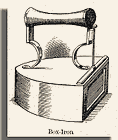 Box-Iron the box-iron: "This iron is similar in shape to the flat-iron, but it is larger and deeper, and, it having a hollow interior, is fitted with solid pieces of metal known as heaters. These being heavy give weight to the iron, and when made red-hot are placed inside the iron for the purpose of heating it." |
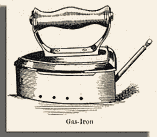 Gas-iron the gas-iron: "The gas-iron is much like the box-iron in size and shape; it also has a hollow interior, but it is heated by means of a jet of gas, conducted to the iron by an india-rubber tube, which is attached to the gas-jet, and burns inside the iron on the bunsen-burner principle." |
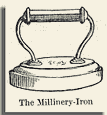 Millinery-iron the millinery-iron: "The millinery-iron . . . is double-pointed, and is so contructed that when the iron is turned round it describes a circle. It is chiefly used for the ironing of crowns and brims of bonnets and hats." |
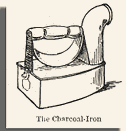 Charcoal-iron the coal-iron: "The charcoal-iron is made . . . on the same principle as the box and gas irons, but it has . . . a large funnel fixed in the front of the iron, for the purpose of conducting the fumes of carbon dioxide from the burning charcoal within. This iron . . . is heated by means of burning charcoal. The method of heating it is as follows:- A piece of charcoal is placed on an iron spoon and ignited; when properly burning, it is placed in the hollow of the iron and surrounded by more charcoal. The lid is then fitted on the iron, which is a few minutes becomes sufficiently hot, and is then ready for use." |
 Egg-iron the egg-iron: "The Egg-Iron is a solid egg-shaped piece of iron fitted on a movable upright stand. It is heated in the usual manner, and is used for ironing the tops of small sleeves or gathered bodices, for which an ordinary iron is not suitable. The egg-iron may be bought single or in sets of four . . ." |
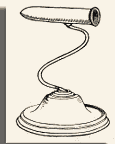 Italian-iron the Italian-iron: "This is quite an old-fashioned iron. It was used in years gone by for the regulation of frills, . . . but its use for that purpose has almost been displaced by the introduction of goffering-tongs and crimping-irons. The iron consists of a hollow tube, fixed horizontally on a stand with a curved arm. The iron proper is made of polished steel, and is heated by a heater of similar composition to that of the box-iron, only this one is attached to a wooden handle . . . This bolt or heater is made red-hot, and placed inside the iron . . . The chief use of the Italian-iron is for the ironing of velvets, or articles that must be ironed without pressure." |
|
  Goffering-tongs and Crimping-tongs and finally, goffering and crimping tongs: "Goffering-Tongs are scissor-shaped, but with rounded points. They are made of iron coated with steel, and are used for the regulation of fully-gathered frills. They should be slightly heated . . . by placing the points in the flame. This must be carefully done, as the coating of steel cracks and eventually peels off if too much heated, with the result that the surface becomes roughened and sticks to the fabric." "Crimping-Tongs are flat-pointed, scissor-shaped irons, with the inner surface of the points fluted. These are best adapted for the regulation of slightly-gathered frills, and for narrow lace edgings of children's garments, to which they give a very delicate finish." |
|
Ironing was practically an art in itself; Margaret Rankin goes on to describe
the seasoning and care of irons, and the other types of equipment needed: laundry
tables, ironing-blankets, ironing-sheets, iron-stands, iron-holders to cover
the iron handle, skirt-boards, shirt and polishing boards, and sleeve-boards.